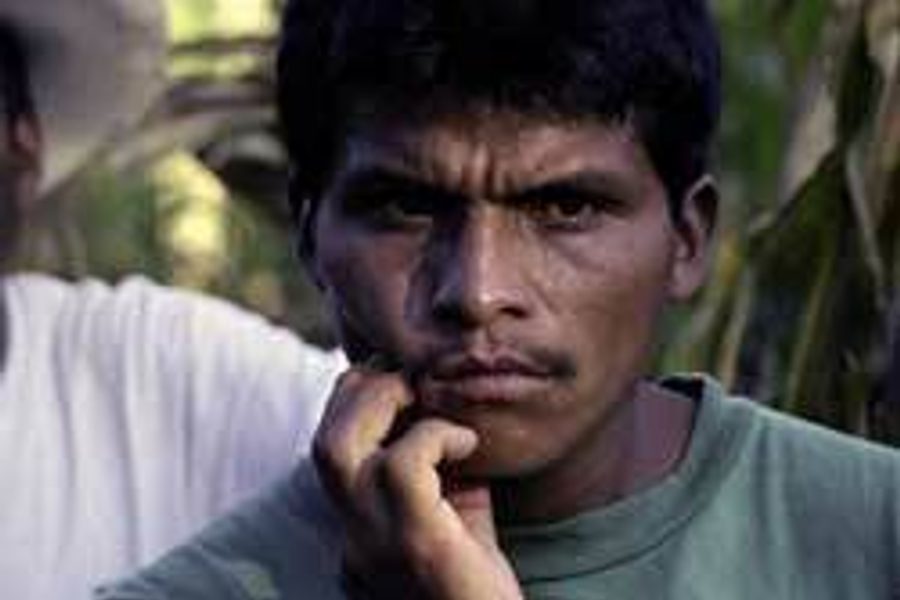
Lacandon Selva Rainforest, Chiapas, Mexico—As all eyes remain on the messy aftermath of the Iraq war and the strategic oil resources of the Persian Gulf, war threatens to return again to the United States’ own “backyard”—southern Mexico and Central America. Here, as in the Gulf, struggles for control of petroleum and other key resources are at stake.
In this past December’s prelude to the anniversary celebrations of their New Year’s Day 1994 armed rebellion, the Maya Indian rebels of the Zapatista National Liberation Army (EZLN) in Mexico’s southern state of Chiapas broke the official silence they had been maintaining since September. The silence, and the breaking off of all dialogue with the government, was an official protest to a Mexican Supreme Court ruling that upheld a series of constitutional reforms on indigenous rights. The constitutional reform package was ostensibly based on the Zapatistas’ peace plan, hashed out painstakingly with federal legislators years earlier.
But the rebels charged that the plan was gutted, with binding provisions on control of territory excised by Congress after the fact. The accord was challenged in the courts by the rebels’ supporters—including indigenous groups and village municipal governments across Mexico—as failing to meet international standards on self-determination. But the Supreme Court ruled it had no jurisdiction to overturn the so-called Indian Rights Law, sending the peace process with the EZLN back to square one nearly nine years after it was initiated.
In the December 29 communique, the Zapatistas asserted their defense of the indigenous autonomous government in the Chiapas rainforest, the rebel zone of the Lacandon Selva. The EZLN’s Subcomandante Marcos pledged that the rebels would resist the government’s planned removal of pro-Zapatista peasant communities from the Montes Azules Biosphere Reserve, in the heart of the Selva. “There will not be a peaceful expulsion,” wrote Marcos.
At this moment, army troops are stationed in the area of the biosphere reserve, awaiting government orders to eject the self-governing rebel Indian communities. Since they emerged in the 1994 rebellion, these jungle “autonomous municipalities” have been protected by the cease-fire under which the peace accords were negotiated. Now President Vicente Fox is preparing to move against the settlements in the name of ecology.
————–
While the Zapatistas say they will refuse to give up their guns until their original peace plan is approved, they have hardly fired a shot in anger since the truce that ended their 1994 uprising. Now, many are growing impatient with the deadlock. On the January 1 anniversary celebrations, 15,000 Zapatistas—masked but unarmed—marched on the Chiapas highlands city of San Cristobal de Las Casas, which the rebels had briefly occupied during the uprising.
Last October 12, hundreds of Zapatista sympathizers marked Dia de la Raza by blocking the entrance to the main Chiapas military base, Rancho Nuevo. They demanded demilitarization of Chiapas and protested Fox’s “Plan Puebla-Panama” (PPP), which calls for a series of new superhighways, ocean-to-ocean pipelines and hydro-electric dams across southern Mexico and Central America as arteries for global trade and development.
“These lands belong to the people and we will not abandon them,” said one protest leader. “The riches belong to those of us who have lived here for centuries and we will oppose their globalization.”
Ironically, just as protecting the biosphere reserve—the embattled and shrinking heart of the rainforest—has become an urgent priority, megadevelopment plans for the Lacandon Selva, put on hold when the Zapatistas seized the jungle in 1994, are now back on track. At the forefront are long-stalled plans for a giant hydro-electric complex on the Usumacinta River, which cuts through the heart of the forest and forms the border with Guatemala. The Inter-American Development Bank has undertaken studies on funding of the project. The oil exploitation plans, which would expand south into the rainforest from the industry’s toxic heartland along the Gulf Coast in Tabasco, are also being revived after nine years.
More ironically still, the Zapatistas and their supporters claim that even the conservation imperative in the U.N.-recognized biosphere reserve masks a corporate agenda. The Maya inhabitants of the Selva, the “autonomous municipalities” loyal to the EZLN, say that—contrary to both U.N. guidelines and the peace plan principles—Montes Azules is not being protected for the resident indigenous peoples, but for transnational biotech corporations that hope to profit from the region’s vast genetic wealth.
————–
Two years ago, the California firm Diversa signed a three-year “bio-prospecting” deal with the Mexican government. Diversa, which has a similar deal with the U.S. Interior Department for Yellowstone National Park, was granted access to Mexico’s biosphere reserves, with areas like Montes Azules especially targeted. In the deal, the government got $5,000 to train and equip personnel from the Mexican National Autonomous University who are actually to collect the samples; $50 per sample; and royalties between 0.3 and 0.5 percent of net sales on products derived. By contrast, the U.S. Interior Department in the Yellowstone deal got $15,000 in equipment, royalties from 0.5 to 10 percent, and a $100,000 fee up front.
The University of Georgia and the U.K.-based Molecular Nature Ltd. have signed on for a similar five-year project. This one, dubbed “Drug Discovery and Biodiversity Among the Maya of Mexico”—specifically targets Chiapas. Hoping to tap the vast reservoir of ancient Maya herblore, the program was to receive $2.5 million from the U.S. International Cooperative Biodiversity Groups (ICBG), a consortium of agencies including the National Institutes of Health, the National Science Foundation, and the Department of Agriculture. Researchers hoped to draw on indigenous healers’ wealth of knowledge on tens of thousands of curative plants in the region. The researchers would share their data with private pharmaceutical and biotech firms that were commercial partners in the deal.
But last year, a coalition of traditional Maya healers in Chiapas declared victory following the cancellation of the ICBG program. The Chiapas Council of Traditional Indigenous Midwives and Healers (COMPITCH) led the campaign against the program, coordinating Maya communities and international environmental groups, such as Canada’s Rural Advancement Foundation International. COMPITCH declared their non-cooperation with the project, and denounced it as “biopiracy,” asserting the impoverished Maya communities would receive little benefit from any patents developed.
Another key player in the privatization of Chiapas biodiversity is Alfonso Romo Garza, an agro-industrialist who has a joint project in the biosphere reserve with Conservation International (of which he is a board member). In 1991, Conservation International brokered a “debt-for-nature” swap, buying a $4 million chunk of Mexico’s debt for the right to establish a genetic research station in Montes Azules. But Romo’s interests may lie less in conservation than expanding control over global agribusiness seed stock through his Monterrey-based Grupo Pulsar.
Romo is also an official promoter of Fox’s PPP, with its visions of interoceanic rail and highway links, industrial pods, and free-trade zones stretching from the Panama Canal to the Mexican state of Puebla. The Zapatistas decry the PPP as a “counterinsurgency” measure aimed at bringing the restive Indian communities of the Mexican south (and Central America) under industrial control.
There is an uneasy symmetry between this mega-scheme and the paradoxically interlocking plan—backed by Conservation International and the World Bank—to integrate Montes Azules into a “Mesoamerican Biological Corridor,” linking the biosphere reserves and other protected rainforests of the isthmus as far south as Panama. This symmetry raises the vision of these tropical forests surviving only as corporate-administrated genetic colonies in the midst of devastated zones of industrial sprawl.
In this past December’s prelude to the anniversary celebrations of their New Year’s Day 1994 armed rebellion, the Maya Indian rebels of the Zapatista National Liberation Army (EZLN) in Mexico’s southern state of Chiapas broke the official silence they had been maintaining since September. The silence, and the breaking off of all dialogue with the government, was an official protest to a Mexican Supreme Court ruling that upheld a series of constitutional reforms on indigenous rights. The constitutional reform package was ostensibly based on the Zapatistas’ peace plan, hashed out painstakingly with federal legislators years earlier.
But the rebels charged that the plan was gutted, with binding provisions on control of territory excised by Congress after the fact. The accord was challenged in the courts by the rebels’ supporters—including indigenous groups and village municipal governments across Mexico—as failing to meet international standards on self-determination. But the Supreme Court ruled it had no jurisdiction to overturn the so-called Indian Rights Law, sending the peace process with the EZLN back to square one nearly nine years after it was initiated.
In the December 29 communique, the Zapatistas asserted their defense of the indigenous autonomous government in the Chiapas rainforest, the rebel zone of the Lacandon Selva. The EZLN’s Subcomandante Marcos pledged that the rebels would resist the government’s planned removal of pro-Zapatista peasant communities from the Montes Azules Biosphere Reserve, in the heart of the Selva. “There will not be a peaceful expulsion,” wrote Marcos.
At this moment, army troops are stationed in the area of the biosphere reserve, awaiting government orders to eject the self-governing rebel Indian communities. Since they emerged in the 1994 rebellion, these jungle “autonomous municipalities” have been protected by the cease-fire under which the peace accords were negotiated. Now President Vicente Fox is preparing to move against the settlements in the name of ecology.
————–
While the Zapatistas say they will refuse to give up their guns until their original peace plan is approved, they have hardly fired a shot in anger since the truce that ended their 1994 uprising. Now, many are growing impatient with the deadlock. On the January 1 anniversary celebrations, 15,000 Zapatistas—masked but unarmed—marched on the Chiapas highlands city of San Cristobal de Las Casas, which the rebels had briefly occupied during the uprising.
Last October 12, hundreds of Zapatista sympathizers marked Dia de la Raza by blocking the entrance to the main Chiapas military base, Rancho Nuevo. They demanded demilitarization of Chiapas and protested Fox’s “Plan Puebla-Panama” (PPP), which calls for a series of new superhighways, ocean-to-ocean pipelines and hydro-electric dams across southern Mexico and Central America as arteries for global trade and development.
“These lands belong to the people and we will not abandon them,” said one protest leader. “The riches belong to those of us who have lived here for centuries and we will oppose their globalization.”
Ironically, just as protecting the biosphere reserve—the embattled and shrinking heart of the rainforest—has become an urgent priority, megadevelopment plans for the Lacandon Selva, put on hold when the Zapatistas seized the jungle in 1994, are now back on track. At the forefront are long-stalled plans for a giant hydro-electric complex on the Usumacinta River, which cuts through the heart of the forest and forms the border with Guatemala. The Inter-American Development Bank has undertaken studies on funding of the project. The oil exploitation plans, which would expand south into the rainforest from the industry’s toxic heartland along the Gulf Coast in Tabasco, are also being revived after nine years.
More ironically still, the Zapatistas and their supporters claim that even the conservation imperative in the U.N.-recognized biosphere reserve masks a corporate agenda. The Maya inhabitants of the Selva, the “autonomous municipalities” loyal to the EZLN, say that—contrary to both U.N. guidelines and the peace plan principles—Montes Azules is not being protected for the resident indigenous peoples, but for transnational biotech corporations that hope to profit from the region’s vast genetic wealth.
————–
Two years ago, the California firm Diversa signed a three-year “bio-prospecting” deal with the Mexican government. Diversa, which has a similar deal with the U.S. Interior Department for Yellowstone National Park, was granted access to Mexico’s biosphere reserves, with areas like Montes Azules especially targeted. In the deal, the government got $5,000 to train and equip personnel from the Mexican National Autonomous University who are actually to collect the samples; $50 per sample; and royalties between 0.3 and 0.5 percent of net sales on products derived. By contrast, the U.S. Interior Department in the Yellowstone deal got $15,000 in equipment, royalties from 0.5 to 10 percent, and a $100,000 fee up front.
The University of Georgia and the U.K.-based Molecular Nature Ltd. have signed on for a similar five-year project. This one, dubbed “Drug Discovery and Biodiversity Among the Maya of Mexico”—specifically targets Chiapas. Hoping to tap the vast reservoir of ancient Maya herblore, the program was to receive $2.5 million from the U.S. International Cooperative Biodiversity Groups (ICBG), a consortium of agencies including the National Institutes of Health, the National Science Foundation, and the Department of Agriculture. Researchers hoped to draw on indigenous healers’ wealth of knowledge on tens of thousands of curative plants in the region. The researchers would share their data with private pharmaceutical and biotech firms that were commercial partners in the deal.
But last year, a coalition of traditional Maya healers in Chiapas declared victory following the cancellation of the ICBG program. The Chiapas Council of Traditional Indigenous Midwives and Healers (COMPITCH) led the campaign against the program, coordinating Maya communities and international environmental groups, such as Canada’s Rural Advancement Foundation International. COMPITCH declared their non-cooperation with the project, and denounced it as “biopiracy,” asserting the impoverished Maya communities would receive little benefit from any patents developed.
Another key player in the privatization of Chiapas biodiversity is Alfonso Romo Garza, an agro-industrialist who has a joint project in the biosphere reserve with Conservation International (of which he is a board member). In 1991, Conservation International brokered a “debt-for-nature” swap, buying a $4 million chunk of Mexico’s debt for the right to establish a genetic research station in Montes Azules. But Romo’s interests may lie less in conservation than expanding control over global agribusiness seed stock through his Monterrey-based Grupo Pulsar.
Romo is also an official promoter of Fox’s PPP, with its visions of interoceanic rail and highway links, industrial pods, and free-trade zones stretching from the Panama Canal to the Mexican state of Puebla. The Zapatistas decry the PPP as a “counterinsurgency” measure aimed at bringing the restive Indian communities of the Mexican south (and Central America) under industrial control.
There is an uneasy symmetry between this mega-scheme and the paradoxically interlocking plan—backed by Conservation International and the World Bank—to integrate Montes Azules into a “Mesoamerican Biological Corridor,” linking the biosphere reserves and other protected rainforests of the isthmus as far south as Panama. This symmetry raises the vision of these tropical forests surviving only as corporate-administrated genetic colonies in the midst of devastated zones of industrial sprawl.
Bill Weinberg is editor of the online World War 4 Report and author of Homage to Chiapas: The New Indigenous Struggles in Mexico (Verso, 2000). He is working on a book on indigenous movements in the Andes.






